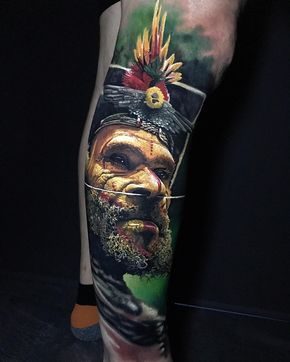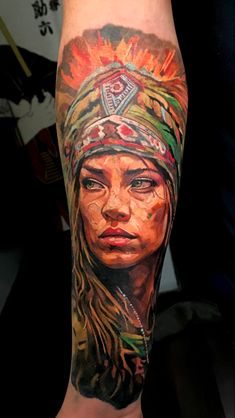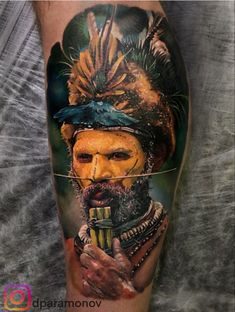
Tribal tattoos are more than just artistic expressions; they are living embodiments of a culture’s history, beliefs, and values. These designs, often intricate and deeply symbolic, are rooted in the traditions of indigenous peoples worldwide. The legacy of tribal ink extends far beyond its visual appeal, offering a window into the soul of ancient communities. This article delves into the cultural significance of indigenous tattoos, exploring their origins, meanings, and enduring influence in contemporary society.
The Origins of Tribal Tattoos
Ancient Beginnings
Tribal tattoos have been a part of human history for thousands of years. Archaeological findings have revealed evidence of tattooing in ancient cultures across the globe. From the mummies of Egypt, dating back to 2000 B.C., to the frozen remains of the Pazyryk culture in Siberia, tattoos have been a universal form of body art, signifying various aspects of life, death, and the spiritual world.
Cultural Significance
For indigenous tribes, tattoos were not merely decorative. They held profound significance, often linked to rites of passage, spiritual beliefs, social status, and personal identity. Each tattoo design carried its own meaning, often unique to the individual and their community. These markings were a way of communicating one’s life story, achievements, and spiritual journey.
The Symbolism Behind Tribal Tattoos
Connection to Nature

One of the most common themes in tribal tattoos is the connection to nature. Indigenous cultures viewed themselves as an integral part of the natural world, and this relationship was often reflected in their tattoo designs. Animals, plants, and celestial bodies were frequently depicted, symbolizing strength, protection, fertility, and guidance.
For example, the Maori of New Zealand are known for their intricate facial tattoos, known as Tā moko. These designs often include elements of nature, such as spirals and curves, representing their connection to the earth and the cosmos.
Spiritual and Religious Beliefs
Many tribal tattoos were deeply intertwined with spiritual and religious beliefs. In Polynesian culture, tattoos were considered sacred, with each design carrying specific meanings related to the gods and the spiritual world. The process of tattooing itself was a ritual, believed to provide protection, strength, and a connection to the divine.

Similarly, in Native American cultures, tattoos were used to invoke the power of spirits and animals. Warriors would often get tattoos of animals they admired, hoping to embody their strength and bravery in battle.
Social Status and Identity
In many indigenous cultures, tattoos were a marker of social status and identity. They indicated a person’s rank within the community, their achievements, and their roles in society. For instance, in some African tribes, facial tattoos were used to distinguish different clans or tribes, serving as a form of identification.
The Samoan Pe’a, a traditional male tattoo, is another example of how tattoos signified social status. Covering the body from the waist to the knees, the Pe’a was a symbol of courage, endurance, and readiness to serve the community. The completion of this tattoo was a rite of passage into manhood and a sign of respect and honor.
The Tattooing Process: A Sacred Ritual
Traditional Methods

The traditional methods of tattooing were often painstaking and required great skill. Indigenous tattoo artists, or shamans, used tools made from bones, wood, or sharp objects to puncture the skin and embed the ink. The process was long and painful, but the pain was seen as a necessary part of the ritual, symbolizing strength, endurance, and sacrifice.
In Borneo, for example, the Kayan tribe used thorny plants as needles, with charcoal as the ink. The tattoos were believed to protect the wearer from harm and guide them in the afterlife.
The Role of the Tattoo Artist
The tattoo artist held a revered position in many indigenous cultures. They were often seen as spiritual leaders or healers, entrusted with the responsibility of bestowing powerful symbols onto the bodies of their people. The act of tattooing was not just a physical procedure but a spiritual journey, where the artist would connect with the individual’s spirit and guide them through the process.
The Evolution of Tribal Tattoos in Modern Times
Revival and Preservation
In recent years, there has been a resurgence of interest in traditional tribal tattoos, both within indigenous communities and among people worldwide. Many indigenous groups are working to preserve their tattooing traditions, reviving ancient techniques and designs as a way to reconnect with their heritage and assert their cultural identity.
For example, in the Philippines, the art of Kalinga tattooing, once on the brink of extinction, has been revived through the efforts of tattoo artist Whang-Od Oggay, who has been practicing the craft for over 80 years. Her work has inspired a new generation to embrace and preserve this ancient art form.
The Global Influence of Tribal Tattoos

Tribal tattoos have transcended cultural boundaries, influencing modern tattoo art globally. Many people today choose tribal designs for their aesthetic appeal, often without fully understanding their cultural significance. While this has led to the widespread popularity of tribal tattoos, it has also raised concerns about cultural appropriation and the loss of the original meanings behind these designs.
It is essential to approach tribal tattoos with respect and awareness, recognizing their cultural roots and the stories they tell. For those outside the indigenous cultures from which these designs originate, it is important to honor the traditions and meanings behind the tattoos, rather than simply adopting them as a fashion statement.
The Cultural Appropriation Debate
Understanding Cultural Appropriation
Cultural appropriation occurs when elements of one culture are adopted by members of another culture, often without understanding or respecting the original context. In the case of tribal tattoos, this can happen when people outside of the culture adopt these designs without understanding their deep cultural and spiritual significance.
For example, traditional Polynesian tattoos carry meanings related to family lineage, social status, and spiritual beliefs. When these designs are used without regard for their significance, it can be seen as a form of disrespect to the culture from which they originate.
The Importance of Cultural Sensitivity
When considering a tribal tattoo, it is crucial to approach the decision with cultural sensitivity and awareness. This means taking the time to learn about the culture, understanding the significance of the design, and recognizing the importance of the tattoo within its cultural context.
For those who choose to adopt tribal designs, it is important to do so in a way that honors the culture and respects the traditions from which the tattoo originates. This might involve consulting with a knowledgeable tattoo artist who understands the cultural significance of the design or choosing a design that resonates with one’s own personal story, rather than simply adopting a popular motif.
Conclusion: The Enduring Legacy of Tribal Ink
Tribal tattoos are more than just beautiful designs; they are a living testament to the history, beliefs, and values of indigenous cultures. Each tattoo carries a story, a piece of the wearer’s identity, and a connection to a rich cultural heritage.
As tribal tattoos continue to influence modern tattoo art, it is essential to remember and respect their origins. By understanding the cultural significance of these designs, we can appreciate the artistry and meaning behind tribal ink and honor the legacy of the indigenous peoples who have passed down this ancient tradition through generations.
Whether you are drawn to tribal tattoos for their aesthetic appeal or their deep cultural significance, remember that these designs are more than just body art; they are a powerful connection to the past, a reflection of identity, and a celebration of the human spirit.





